Auditing and Assurance Report: Evaluating Auditor Independence Threats
VerifiedAdded on 2019/10/31
|7
|1593
|182
Report
AI Summary
This report provides an in-depth analysis of auditing and assurance principles, focusing on auditor independence and potential threats. It examines several scenarios, including self-review, familiarity, and intimidation threats, and their impact on the integrity of the audit process. The report explores cases where auditors' objectivity may be compromised due to their relationships with clients, such as when an auditor reviews their own work or when there are close personal ties between the auditor and the client's staff. It also discusses the importance of the audit report, its key sections, and how it communicates the auditor's opinion on the financial statements. The report highlights the significance of maintaining auditor independence to ensure the reliability of financial information and uphold the trust of stakeholders. The report is supported by several references from academic journals and publications.
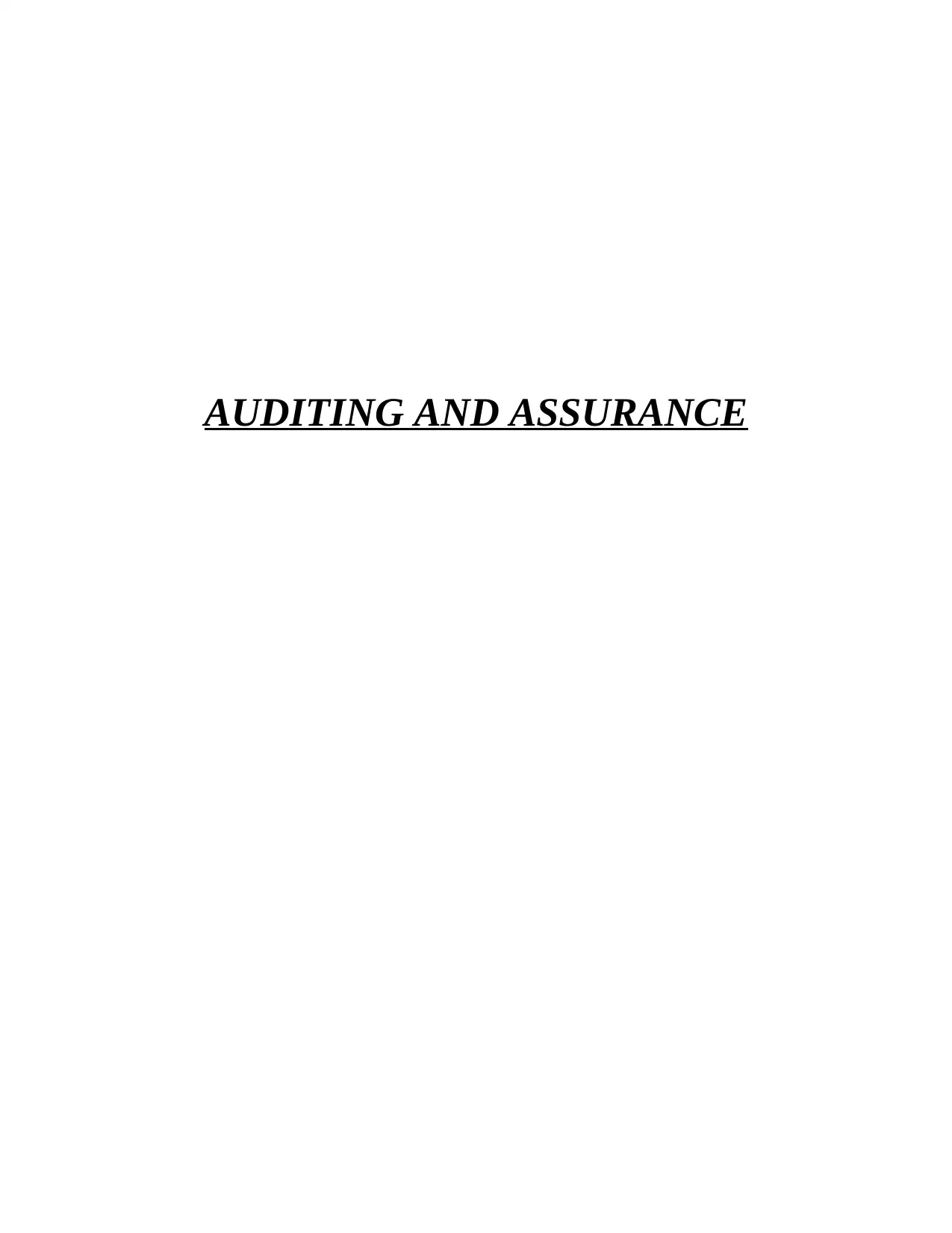
AUDITING AND ASSURANCE
Paraphrase This Document
Need a fresh take? Get an instant paraphrase of this document with our AI Paraphraser
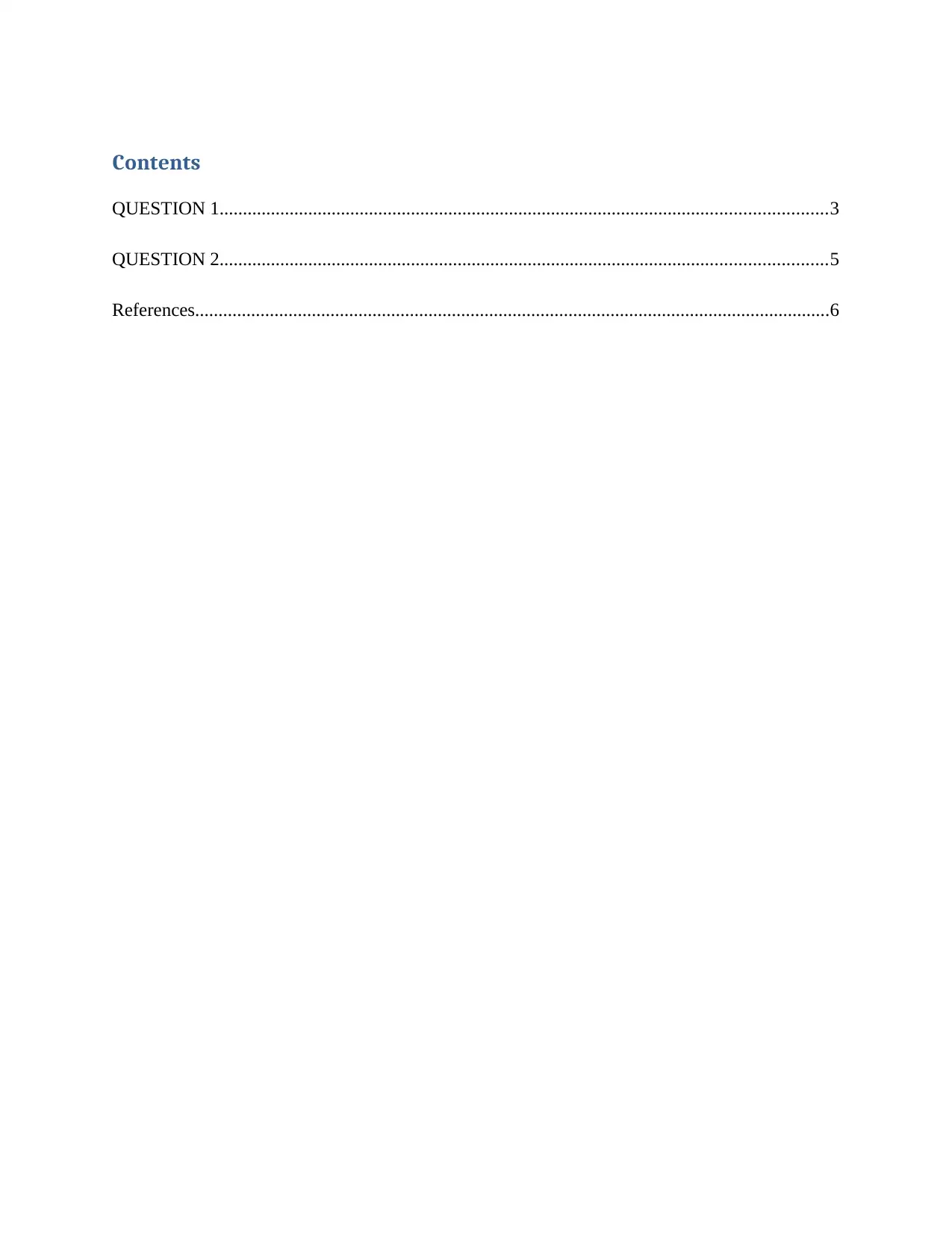
Contents
QUESTION 1..................................................................................................................................3
QUESTION 2..................................................................................................................................5
References........................................................................................................................................6
QUESTION 1..................................................................................................................................3
QUESTION 2..................................................................................................................................5
References........................................................................................................................................6
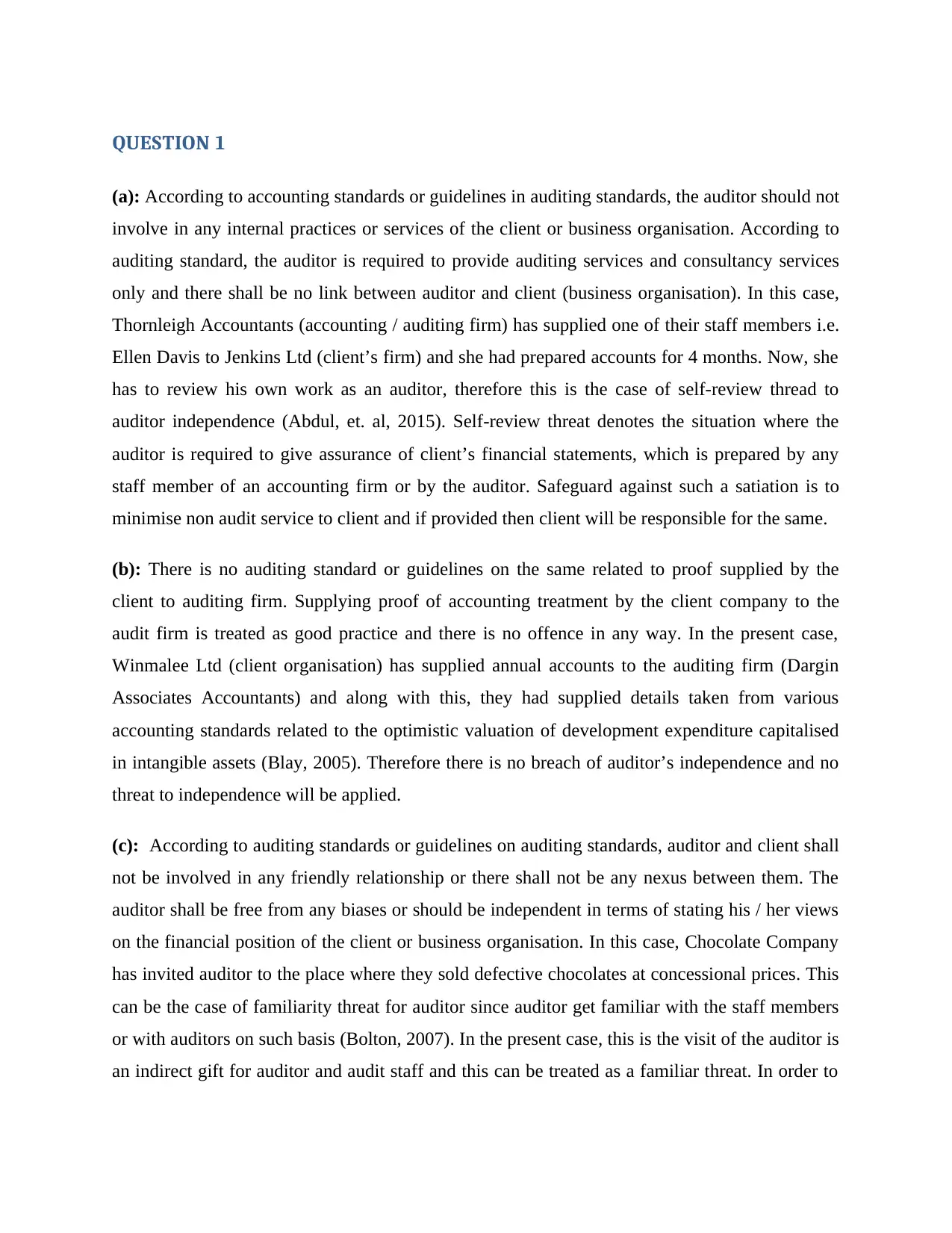
QUESTION 1
(a): According to accounting standards or guidelines in auditing standards, the auditor should not
involve in any internal practices or services of the client or business organisation. According to
auditing standard, the auditor is required to provide auditing services and consultancy services
only and there shall be no link between auditor and client (business organisation). In this case,
Thornleigh Accountants (accounting / auditing firm) has supplied one of their staff members i.e.
Ellen Davis to Jenkins Ltd (client’s firm) and she had prepared accounts for 4 months. Now, she
has to review his own work as an auditor, therefore this is the case of self-review thread to
auditor independence (Abdul, et. al, 2015). Self-review threat denotes the situation where the
auditor is required to give assurance of client’s financial statements, which is prepared by any
staff member of an accounting firm or by the auditor. Safeguard against such a satiation is to
minimise non audit service to client and if provided then client will be responsible for the same.
(b): There is no auditing standard or guidelines on the same related to proof supplied by the
client to auditing firm. Supplying proof of accounting treatment by the client company to the
audit firm is treated as good practice and there is no offence in any way. In the present case,
Winmalee Ltd (client organisation) has supplied annual accounts to the auditing firm (Dargin
Associates Accountants) and along with this, they had supplied details taken from various
accounting standards related to the optimistic valuation of development expenditure capitalised
in intangible assets (Blay, 2005). Therefore there is no breach of auditor’s independence and no
threat to independence will be applied.
(c): According to auditing standards or guidelines on auditing standards, auditor and client shall
not be involved in any friendly relationship or there shall not be any nexus between them. The
auditor shall be free from any biases or should be independent in terms of stating his / her views
on the financial position of the client or business organisation. In this case, Chocolate Company
has invited auditor to the place where they sold defective chocolates at concessional prices. This
can be the case of familiarity threat for auditor since auditor get familiar with the staff members
or with auditors on such basis (Bolton, 2007). In the present case, this is the visit of the auditor is
an indirect gift for auditor and audit staff and this can be treated as a familiar threat. In order to
(a): According to accounting standards or guidelines in auditing standards, the auditor should not
involve in any internal practices or services of the client or business organisation. According to
auditing standard, the auditor is required to provide auditing services and consultancy services
only and there shall be no link between auditor and client (business organisation). In this case,
Thornleigh Accountants (accounting / auditing firm) has supplied one of their staff members i.e.
Ellen Davis to Jenkins Ltd (client’s firm) and she had prepared accounts for 4 months. Now, she
has to review his own work as an auditor, therefore this is the case of self-review thread to
auditor independence (Abdul, et. al, 2015). Self-review threat denotes the situation where the
auditor is required to give assurance of client’s financial statements, which is prepared by any
staff member of an accounting firm or by the auditor. Safeguard against such a satiation is to
minimise non audit service to client and if provided then client will be responsible for the same.
(b): There is no auditing standard or guidelines on the same related to proof supplied by the
client to auditing firm. Supplying proof of accounting treatment by the client company to the
audit firm is treated as good practice and there is no offence in any way. In the present case,
Winmalee Ltd (client organisation) has supplied annual accounts to the auditing firm (Dargin
Associates Accountants) and along with this, they had supplied details taken from various
accounting standards related to the optimistic valuation of development expenditure capitalised
in intangible assets (Blay, 2005). Therefore there is no breach of auditor’s independence and no
threat to independence will be applied.
(c): According to auditing standards or guidelines on auditing standards, auditor and client shall
not be involved in any friendly relationship or there shall not be any nexus between them. The
auditor shall be free from any biases or should be independent in terms of stating his / her views
on the financial position of the client or business organisation. In this case, Chocolate Company
has invited auditor to the place where they sold defective chocolates at concessional prices. This
can be the case of familiarity threat for auditor since auditor get familiar with the staff members
or with auditors on such basis (Bolton, 2007). In the present case, this is the visit of the auditor is
an indirect gift for auditor and audit staff and this can be treated as a familiar threat. In order to
⊘ This is a preview!⊘
Do you want full access?
Subscribe today to unlock all pages.

Trusted by 1+ million students worldwide
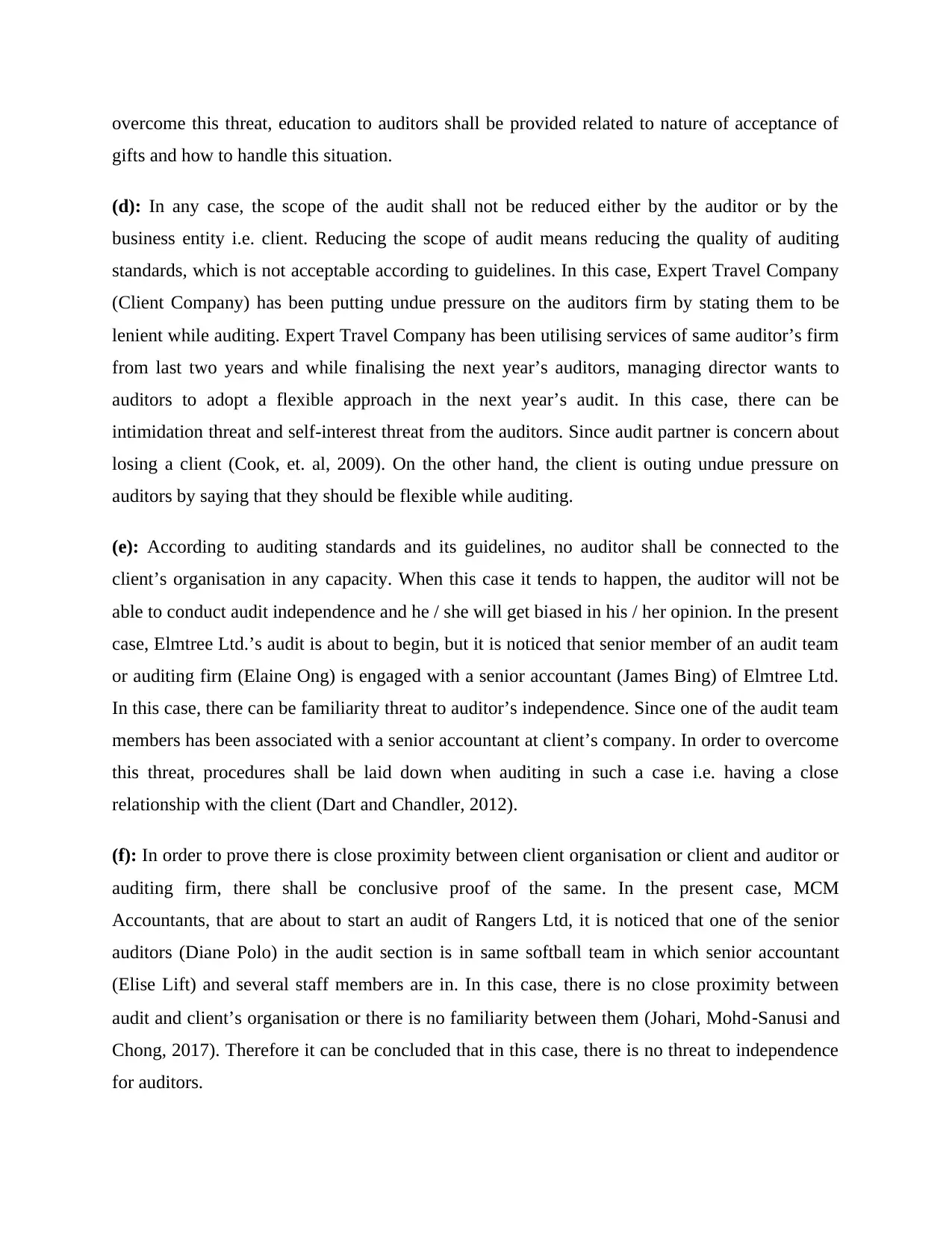
overcome this threat, education to auditors shall be provided related to nature of acceptance of
gifts and how to handle this situation.
(d): In any case, the scope of the audit shall not be reduced either by the auditor or by the
business entity i.e. client. Reducing the scope of audit means reducing the quality of auditing
standards, which is not acceptable according to guidelines. In this case, Expert Travel Company
(Client Company) has been putting undue pressure on the auditors firm by stating them to be
lenient while auditing. Expert Travel Company has been utilising services of same auditor’s firm
from last two years and while finalising the next year’s auditors, managing director wants to
auditors to adopt a flexible approach in the next year’s audit. In this case, there can be
intimidation threat and self-interest threat from the auditors. Since audit partner is concern about
losing a client (Cook, et. al, 2009). On the other hand, the client is outing undue pressure on
auditors by saying that they should be flexible while auditing.
(e): According to auditing standards and its guidelines, no auditor shall be connected to the
client’s organisation in any capacity. When this case it tends to happen, the auditor will not be
able to conduct audit independence and he / she will get biased in his / her opinion. In the present
case, Elmtree Ltd.’s audit is about to begin, but it is noticed that senior member of an audit team
or auditing firm (Elaine Ong) is engaged with a senior accountant (James Bing) of Elmtree Ltd.
In this case, there can be familiarity threat to auditor’s independence. Since one of the audit team
members has been associated with a senior accountant at client’s company. In order to overcome
this threat, procedures shall be laid down when auditing in such a case i.e. having a close
relationship with the client (Dart and Chandler, 2012).
(f): In order to prove there is close proximity between client organisation or client and auditor or
auditing firm, there shall be conclusive proof of the same. In the present case, MCM
Accountants, that are about to start an audit of Rangers Ltd, it is noticed that one of the senior
auditors (Diane Polo) in the audit section is in same softball team in which senior accountant
(Elise Lift) and several staff members are in. In this case, there is no close proximity between
audit and client’s organisation or there is no familiarity between them (Johari, Mohd‐Sanusi and
Chong, 2017). Therefore it can be concluded that in this case, there is no threat to independence
for auditors.
gifts and how to handle this situation.
(d): In any case, the scope of the audit shall not be reduced either by the auditor or by the
business entity i.e. client. Reducing the scope of audit means reducing the quality of auditing
standards, which is not acceptable according to guidelines. In this case, Expert Travel Company
(Client Company) has been putting undue pressure on the auditors firm by stating them to be
lenient while auditing. Expert Travel Company has been utilising services of same auditor’s firm
from last two years and while finalising the next year’s auditors, managing director wants to
auditors to adopt a flexible approach in the next year’s audit. In this case, there can be
intimidation threat and self-interest threat from the auditors. Since audit partner is concern about
losing a client (Cook, et. al, 2009). On the other hand, the client is outing undue pressure on
auditors by saying that they should be flexible while auditing.
(e): According to auditing standards and its guidelines, no auditor shall be connected to the
client’s organisation in any capacity. When this case it tends to happen, the auditor will not be
able to conduct audit independence and he / she will get biased in his / her opinion. In the present
case, Elmtree Ltd.’s audit is about to begin, but it is noticed that senior member of an audit team
or auditing firm (Elaine Ong) is engaged with a senior accountant (James Bing) of Elmtree Ltd.
In this case, there can be familiarity threat to auditor’s independence. Since one of the audit team
members has been associated with a senior accountant at client’s company. In order to overcome
this threat, procedures shall be laid down when auditing in such a case i.e. having a close
relationship with the client (Dart and Chandler, 2012).
(f): In order to prove there is close proximity between client organisation or client and auditor or
auditing firm, there shall be conclusive proof of the same. In the present case, MCM
Accountants, that are about to start an audit of Rangers Ltd, it is noticed that one of the senior
auditors (Diane Polo) in the audit section is in same softball team in which senior accountant
(Elise Lift) and several staff members are in. In this case, there is no close proximity between
audit and client’s organisation or there is no familiarity between them (Johari, Mohd‐Sanusi and
Chong, 2017). Therefore it can be concluded that in this case, there is no threat to independence
for auditors.
Paraphrase This Document
Need a fresh take? Get an instant paraphrase of this document with our AI Paraphraser

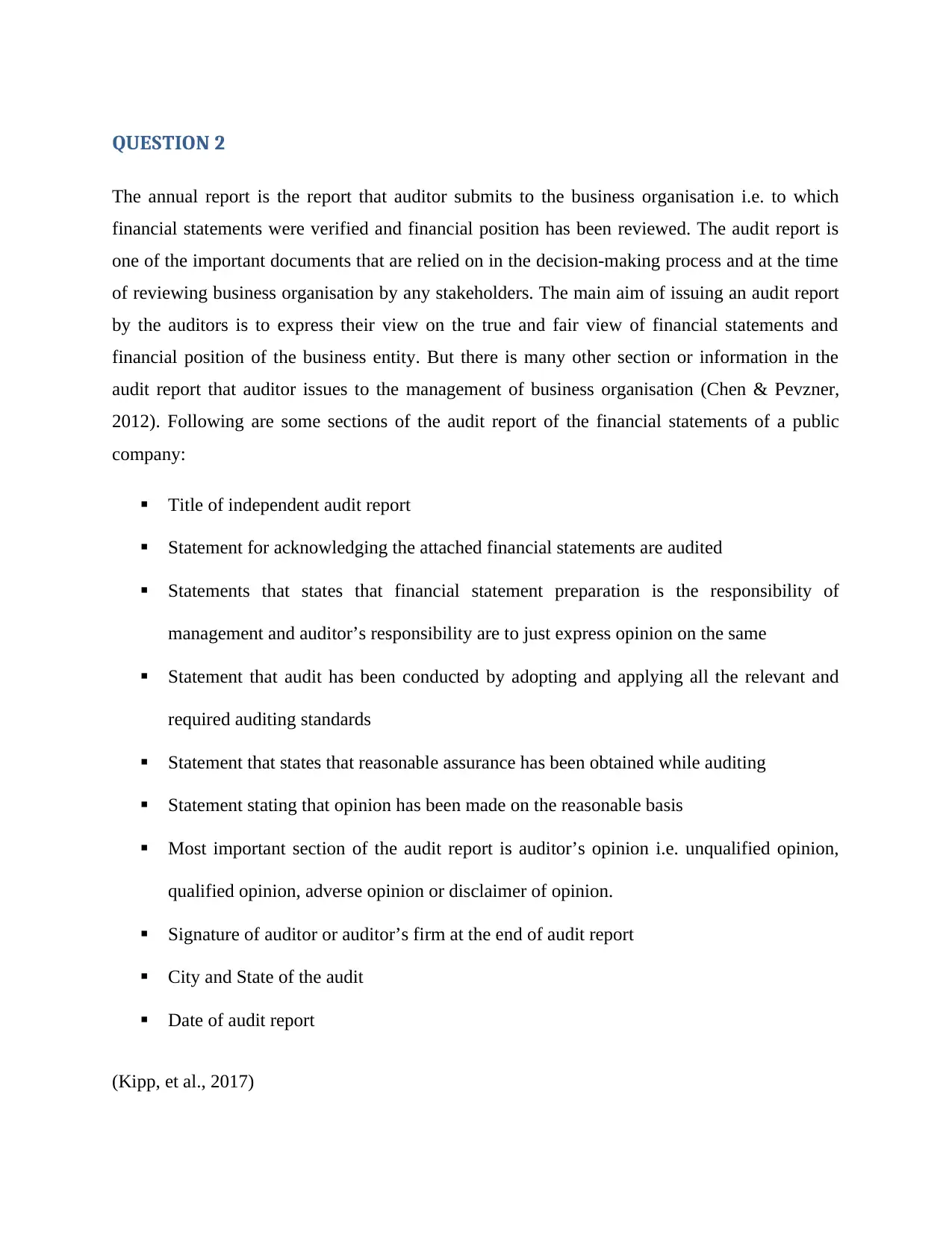
QUESTION 2
The annual report is the report that auditor submits to the business organisation i.e. to which
financial statements were verified and financial position has been reviewed. The audit report is
one of the important documents that are relied on in the decision-making process and at the time
of reviewing business organisation by any stakeholders. The main aim of issuing an audit report
by the auditors is to express their view on the true and fair view of financial statements and
financial position of the business entity. But there is many other section or information in the
audit report that auditor issues to the management of business organisation (Chen & Pevzner,
2012). Following are some sections of the audit report of the financial statements of a public
company:
Title of independent audit report
Statement for acknowledging the attached financial statements are audited
Statements that states that financial statement preparation is the responsibility of
management and auditor’s responsibility are to just express opinion on the same
Statement that audit has been conducted by adopting and applying all the relevant and
required auditing standards
Statement that states that reasonable assurance has been obtained while auditing
Statement stating that opinion has been made on the reasonable basis
Most important section of the audit report is auditor’s opinion i.e. unqualified opinion,
qualified opinion, adverse opinion or disclaimer of opinion.
Signature of auditor or auditor’s firm at the end of audit report
City and State of the audit
Date of audit report
(Kipp, et al., 2017)
The annual report is the report that auditor submits to the business organisation i.e. to which
financial statements were verified and financial position has been reviewed. The audit report is
one of the important documents that are relied on in the decision-making process and at the time
of reviewing business organisation by any stakeholders. The main aim of issuing an audit report
by the auditors is to express their view on the true and fair view of financial statements and
financial position of the business entity. But there is many other section or information in the
audit report that auditor issues to the management of business organisation (Chen & Pevzner,
2012). Following are some sections of the audit report of the financial statements of a public
company:
Title of independent audit report
Statement for acknowledging the attached financial statements are audited
Statements that states that financial statement preparation is the responsibility of
management and auditor’s responsibility are to just express opinion on the same
Statement that audit has been conducted by adopting and applying all the relevant and
required auditing standards
Statement that states that reasonable assurance has been obtained while auditing
Statement stating that opinion has been made on the reasonable basis
Most important section of the audit report is auditor’s opinion i.e. unqualified opinion,
qualified opinion, adverse opinion or disclaimer of opinion.
Signature of auditor or auditor’s firm at the end of audit report
City and State of the audit
Date of audit report
(Kipp, et al., 2017)
⊘ This is a preview!⊘
Do you want full access?
Subscribe today to unlock all pages.

Trusted by 1+ million students worldwide
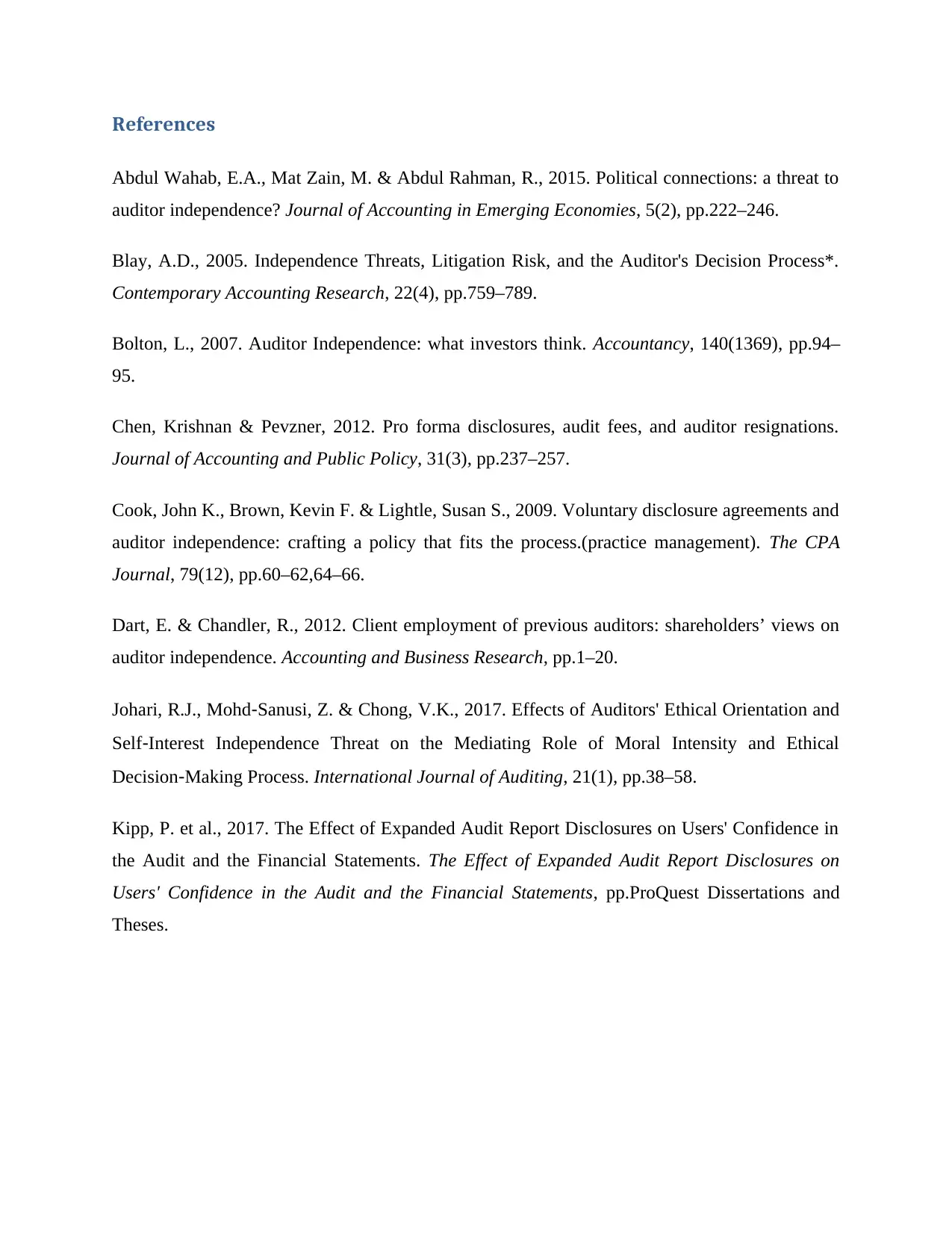
References
Abdul Wahab, E.A., Mat Zain, M. & Abdul Rahman, R., 2015. Political connections: a threat to
auditor independence? Journal of Accounting in Emerging Economies, 5(2), pp.222–246.
Blay, A.D., 2005. Independence Threats, Litigation Risk, and the Auditor's Decision Process*.
Contemporary Accounting Research, 22(4), pp.759–789.
Bolton, L., 2007. Auditor Independence: what investors think. Accountancy, 140(1369), pp.94–
95.
Chen, Krishnan & Pevzner, 2012. Pro forma disclosures, audit fees, and auditor resignations.
Journal of Accounting and Public Policy, 31(3), pp.237–257.
Cook, John K., Brown, Kevin F. & Lightle, Susan S., 2009. Voluntary disclosure agreements and
auditor independence: crafting a policy that fits the process.(practice management). The CPA
Journal, 79(12), pp.60–62,64–66.
Dart, E. & Chandler, R., 2012. Client employment of previous auditors: shareholders’ views on
auditor independence. Accounting and Business Research, pp.1–20.
Johari, R.J., Mohd‐Sanusi, Z. & Chong, V.K., 2017. Effects of Auditors' Ethical Orientation and
Self‐Interest Independence Threat on the Mediating Role of Moral Intensity and Ethical
Decision‐Making Process. International Journal of Auditing, 21(1), pp.38–58.
Kipp, P. et al., 2017. The Effect of Expanded Audit Report Disclosures on Users' Confidence in
the Audit and the Financial Statements. The Effect of Expanded Audit Report Disclosures on
Users' Confidence in the Audit and the Financial Statements, pp.ProQuest Dissertations and
Theses.
Abdul Wahab, E.A., Mat Zain, M. & Abdul Rahman, R., 2015. Political connections: a threat to
auditor independence? Journal of Accounting in Emerging Economies, 5(2), pp.222–246.
Blay, A.D., 2005. Independence Threats, Litigation Risk, and the Auditor's Decision Process*.
Contemporary Accounting Research, 22(4), pp.759–789.
Bolton, L., 2007. Auditor Independence: what investors think. Accountancy, 140(1369), pp.94–
95.
Chen, Krishnan & Pevzner, 2012. Pro forma disclosures, audit fees, and auditor resignations.
Journal of Accounting and Public Policy, 31(3), pp.237–257.
Cook, John K., Brown, Kevin F. & Lightle, Susan S., 2009. Voluntary disclosure agreements and
auditor independence: crafting a policy that fits the process.(practice management). The CPA
Journal, 79(12), pp.60–62,64–66.
Dart, E. & Chandler, R., 2012. Client employment of previous auditors: shareholders’ views on
auditor independence. Accounting and Business Research, pp.1–20.
Johari, R.J., Mohd‐Sanusi, Z. & Chong, V.K., 2017. Effects of Auditors' Ethical Orientation and
Self‐Interest Independence Threat on the Mediating Role of Moral Intensity and Ethical
Decision‐Making Process. International Journal of Auditing, 21(1), pp.38–58.
Kipp, P. et al., 2017. The Effect of Expanded Audit Report Disclosures on Users' Confidence in
the Audit and the Financial Statements. The Effect of Expanded Audit Report Disclosures on
Users' Confidence in the Audit and the Financial Statements, pp.ProQuest Dissertations and
Theses.
1 out of 7
Related Documents
Your All-in-One AI-Powered Toolkit for Academic Success.
+13062052269
info@desklib.com
Available 24*7 on WhatsApp / Email
![[object Object]](/_next/static/media/star-bottom.7253800d.svg)
Unlock your academic potential
Copyright © 2020–2025 A2Z Services. All Rights Reserved. Developed and managed by ZUCOL.




